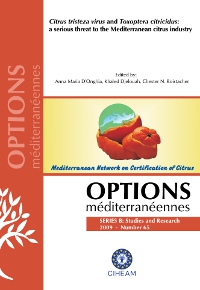| Article précédent | p. 111-113 | Article suivant |
State of the art of Citrus tristeza virus (CTV) in Egypt
Citrus industry is the major fruit crop in Egypt; Citrus tristeza virus (CTV) was reported in the country in 1957, where 4 trees were found to be infected. In 2000, a large-scale CTV survey was carried out, reporting several other CTV outbreaks, in different governorates. Preliminary data based on CTV molecular characterization suggest that some CTV isolates are very similar to the severe strain from Florida, that causes quick decline and stem pitting. In contrast, sthe seedling yellows component seems not be present. The possible entrance of Toxoptera citricidus and the use of a CTV susceptible rootstock (sour orange) pose today a major threat to the Egyptian citrus industry.
Les agrumes constituent la principale culture fruitière en Egypte ; le virus de la tristeza des agrumes (CTV) a été signalé pour la première fois en 1957 dans ce pays, où quatre arbres étaient infectés. En 2000, une enquête sur le CTV a été réalisée sur une grande échelle, permettant de déceler plusieurs autres foyers d'infection dans de nombreux gouvernorats. Les données préliminaires, basées sur la caractérisation moléculaire du CTV, indiquent une similitude entre certains isolats de CTV et la souche sévère connue en Floride, induisant le quick decline et le stem pitting. En revanche, la souche qui cause le seedling yellows semble ne pas être présente. La possible introduction du Toxoptera citricidus et l'utilisation d'un porte-greffe sensible au CTV (le bigaradier) semblent représenter une menace considérable pour l'agrumiculture égyptienne.
- [ Afficher ]
- [ Télécharger ]
- [ Exporter la citation ]
Vous pouvez télécharger la citation au format :
- [ Imprimer ]
-
Mots-clés
AGRUME, CITRUS, CLOSTEROVIRUS TRISTEZA DU CITRUS, EGYPTE, HISTOIRE, BIGARADECiter cet article
Fahmy H., Salama E., D'Onghia A.M. State of the art of Citrus tristeza virus (CTV) in Egypt. In : D'Onghia A.M. (ed.), Djelouah K. (ed.), Roistacher C.N. (ed.). Citrus tristeza virus and Toxoptera citricidus: a serious threat to the Mediterranean citrus industry. Bari : CIHEAM, 2009. p. 111-113. (Options Méditerranéennes : Série B. Etudes et Recherches; n. 65). http://om.ciheam.org/om/pdf/b65/00801399.pdf



